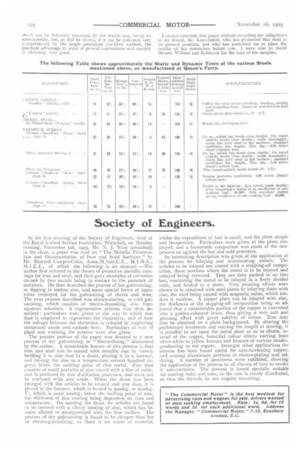Society of Engineers.
Page 30

If you've noticed an error in this article please click here to report it so we can fix it.
At the last meeting of the Society, of Engineers, held at the Royal United Service Institution, Whitehall, on Monday evening, November 6th, 1905, Mr. N. J. West (president) in the chair, a paper was read on " The Metallic Preservation and Ornamentation of Iron and Steel Surfaces " by Mr. Sherard Cowper-Coles, Assoc.M.Inst.C.E., M.1.M.E., M.I.E.E., of which the following is an abstract :—The author first referred to the theory of protective metallic coatings for iron and steel, and then gave examples of corrosion caused by two metals being in contact in the presence of moisture. He then described the process of hot galvanising, or dipping in molten zinc, and some special forms of apparatus employed for the galvanising of sheets and wire. The next process described was electro-zincing, or cold galvanising, which consists of electro-depositing zinc from aqueous solutions. A regenerative process was then described : particulars were given of the way in which zinc dust is employed to regenerate the electrolyte, and of how the voltage between the electrodes is reduced by employing compound anode and cathode bars. Particulars of cost of plant and working the process were also given. The greater portion of the paper was devoted to a new process of dry galvanising or Sherardising," discovered by the author. A remarkable feature of this process is that iron and steel can be coated with metallic zinc by merely bedding it in zinc dust in a drum, placing it in a furnace, and raising the zinc to a temperature several hundred degrees below the melting point of that metal. Zinc dust consists of small particles of zinc coated with a film of oxide, and is produced by zinc distillation processes, and must net be confused with zinc oxide. When the drum has been charged with the articles to be treated and zinc dust, it is placed in the furnace, which is heated to 500deg. or 600deg. F., which is some zoodeg. below the melting point of zinc, the thickness of zinc coating being dependent on time and temperature. On opening the drum the articles are found to be covered with a silvery coating of zinc, which has become alloyed or amalgamated with the iron surface. The process of dry galvanising is found to he cheaper than hot or electro-galvanising, as there is no waste of material,
whilst the expenditure of fuel is small, and the plant simple and inexpensive. Particulars were given of the plant employed, and a favourable comparison was made of the new process as against the hot and cold processes.
An interesting description was given of the application of the process for inlaying and ornamenting metals. The articles to be inlayed are coated with a stopping-off composition, those portions where the metal is to be inlayed and onlayed being removed. They are then packed in an iron box, containing the metal to be inlayed in a finely divided state, and heated in a stove. Very pleasing effects were shown to be obtained with steel plates by inlaying them with zinc, the steel being coated with magnetic oxide, which renders it rustless. A copper plate can be inlayed with zinc, the thickness of the stopping-off composition being so adjusted that a considerable portion of the copper is converted into a golden-coloured brass, thus giving a very soft and pleasing effect with great subtlety of colour. Zinc may also be obtained on a plain background. By altering the preliminary treatment and varying the length of stoving, it is possible to act upon the metal plate so as to obtain, instead of the copper, beautiful colour effects varying from silver-white to yellow brasses and bronzes of various shades, graduating to red copper. Amongst other applications the process has been found useful for case-hardening copper, and coating aluminium previous to electro-plating and soldering. A number of specimens were exhibited, showing the application of the process to all classes of iron to render it non-corrosive. The process is found specially suitable for coating bolts and nuts, as the zinc is evenly distributed, so that the threads do not require re-cutting.
































